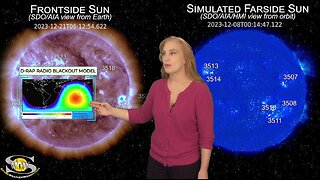Premium Only Content

Biggest X-Flare of Cycle 25 & Super Storm Launch | Space Weather Spotlight 02 January 2024
This Space Weather News forecast sponsored in part by Millersville University:
https://www.millersville.edu/swen
Our Sun rings in the New Year with some fireworks of its own. Old Region 3514 (newly numbered 3536) fires off an X4.98-flare and launches a super solar storm that will likely give Earth a glancing blow sometime on January 2-3. Aurora photographers may get some aurora from this side-swiping storm, especially at high latitudes where shows are already occurring due to the effect of the fast solar wind stream hitting Earth now. The storm isn't expected to cause a huge or lasting disruption, but it could boost aurora views even down at mid-latitudes for a short bit. Amateur radio operators and GPS users should expect signal disruptions on Earth's dayside due to periodic radio blackouts over much of this week as Region 3536 and others in this active region cluster continue to rotate into view. Watch the big X-class flare and it's impacts at earth, learn the details of the coming solar storm, and see what else our Sun has in store.
Want early access to these forecasts, tutorials on Space Weather, & more? Visit:
https://patreon.com/SpaceweatherWoman
This Space Weather News forecast sponsored in part by Millersville University:
https://www.millersville.edu/swen
Our Sun rings in the New Year with some fireworks of its own. Old Region 3514 (newly numbered 3536) fires off an X4.98-flare and launches a super solar storm that will likely give Earth a glancing blow sometime on January 2-3. Aurora photographers may get some aurora from this side-swiping storm, especially at high latitudes where shows are already occurring due to the effect of the fast solar wind stream hitting Earth now. The storm isn't expected to cause a huge or lasting disruption, but it could boost aurora views even down at mid-latitudes for a short bit. Amateur radio operators and GPS users should expect signal disruptions on Earth's dayside due to periodic radio blackouts over much of this week as Region 3536 and others in this active region cluster continue to rotate into view. Watch the big X-class flare and it's impacts at earth, learn the details of the coming solar storm, and see what else our Sun has in store.
Want early access to these forecasts, tutorials on Space Weather, & more? Visit:
https://patreon.com/SpaceweatherWoman
For daily and often hourly updates (during active times) visit me on Twitter:
https://twitter.com/TamithaSkov
For a more in-depth look at the data and images highlighted in this video see these links below.
Solar Imaging and Analysis:
SDO: http://sdo.gsfc.nasa.gov/data/
Helioviewer: http://www.helioviewer.org/
Flare Analysis: http://www.lmsal.com/solarsoft/latest_events/
Computer Aided CME Tracking CACTUS: http://www.sidc.oma.be/cactus/out/latestCMEs.html
GOES Xray: http://www.swpc.noaa.gov/rt_plots/xray_1m.html
SOHO: http://sohodata.nascom.nasa.gov/
Stereo: http://stereo.gsfc.nasa.gov/
GONG magnetic field synoptic movie: https://gong.nso.edu/data/magmap/standard_movie.html
GONG magnetic field synoptic charts: http://gong.nso.edu/data/magmap/
LMSAL Heliophysics Events HEK http://www.lmsal.com/isolsearch
Solar Wind:
DISCOVR solar wind: http://www.swpc.noaa.gov/products/real-time-solar-wind
ACE Solar Wind: http://www.swpc.noaa.gov/products/ace-real-time-solar-wind
NASA/CCMC/M2M Enlil Solar Storm Prediction Model: https://iswa.gsfc.nasa.gov/IswaSystemWebApp/iSWACygnetStreamer?timestamp=2038-01-23+00%3A44%3A00&window=-1&cygnetId=261
NOAA/SWPC Enlil Solar Storm Prediction Model: http://www.swpc.noaa.gov/products/wsa-enlil-solar-wind-prediction
Magnetosphere, Ionosphere, Atmosphere:
GOES Magnetometer: http://www.swpc.noaa.gov/products/goes-magnetometer
Ionosphere D-Region Absorption (DRAP) model: http://www.swpc.noaa.gov/products/d-region-absorption-predictions-d-rap/
Radio Propagation: https://www.tvcomm.co.uk/g7izu/atlantic-mf-hf-propagation-20min-persistence/
Near-Earth radiation environment: https://spaceweather.gfz-potsdam.de/products-data/forecasts
Auroral Oval Ovation Products: http://www.swpc.noaa.gov/products/aurora-30-minute-forecast
Global 3-hr Kp index: http://www.swpc.noaa.gov/products/planetary-k-index
GEOCHRON Weather Display: www.geochron.com
USGS Ground Magnetometers: http://geomag.usgs.gov/realtime/
Multi-Purpose Space Environment Sites:
NOAA/SWPC: http://www.swpc.noaa.gov
SOLARHAM: http://www.solarham.net/index.htm
Spaceweather: http://spaceweather.com
iSWA: http://iswa.gsfc.nasa.gov/iswa/iSWA.html
Definition of Geomagnetic Storm, Radiation Storm, and Radio Blackout Levels:
http://www.swpc.noaa.gov/NOAAscales/
None of this would be possible without the hard work and dedication of those who have provided all of this data for public use.
Images c/o NASA/NOAA/ESA/CSA (most notably the superb SDO, SOHO, ACE, DSCOVR, STEREO, CCMC, M2M, JPL & DSN teams, amazing professionals, hobbyists, institutions, organizations, agencies and amateurs such as those at the USAF/HAARP, NICT, NOAA, USGS, Environment Canada, Natural Resources Canada, Intellicast, Catatania, rice.edu, wisc.edu, sonoma.edu ucalgary.ca, rssi.ru, ohio-state.edu, solen.info, and so much more. Thanks for making Space Weather part of our every day dialogue.
-
 10:26
10:26
Dr. Tamitha Skov
11 months ago $0.01 earnedA Big Solar Flare & a Filament Poised to Erupt | Space Weather News 22 December 2023
1101 -
 LIVE
LIVE
Tucker Carlson
2 hours ago“I’ll Win With or Without You,” Teamsters Union President Reveals Kamala Harris’s Famous Last Words
8,859 watching -
 LIVE
LIVE
The Dan Bongino Show
2 hours agoLIVE: The Dan Bongino Radio Show - 12/23/24
25,570 watching -
 LIVE
LIVE
The Dilley Show
2 hours agoTrump Conquering Western Hemisphere? w/Author Brenden Dilley 12/23/2024
3,810 watching -
 1:09:59
1:09:59
Geeks + Gamers
3 hours agoSonic 3 DESTROYS Mufasa And Disney, Naughty Dog Actress SLAMS Gamers Over Intergalactic
18.8K1 -
 51:59
51:59
The Dan Bongino Show
4 hours agoDemocrat Donor Admits The Scary Truth (Ep. 2393) - 12/23/2024
496K1.31K -
 2:32:15
2:32:15
Matt Kohrs
15 hours agoRumble CEO Chris Pavlovski Talks $775M Tether Partnership || The MK Show
83.5K23 -
 28:23
28:23
Dave Portnoy
15 hours agoDavey Day Trader Presented by Kraken - December 23, 2024
98K32 -
 59:29
59:29
BonginoReport
6 hours agoTrump, Murder Plots, and the Christmas Miracle: Evita + Jack Posobiec (Ep.110) - 12/23/2024
111K87 -
 2:59:14
2:59:14
Wendy Bell Radio
8 hours agoNothing To See Here
97.4K56